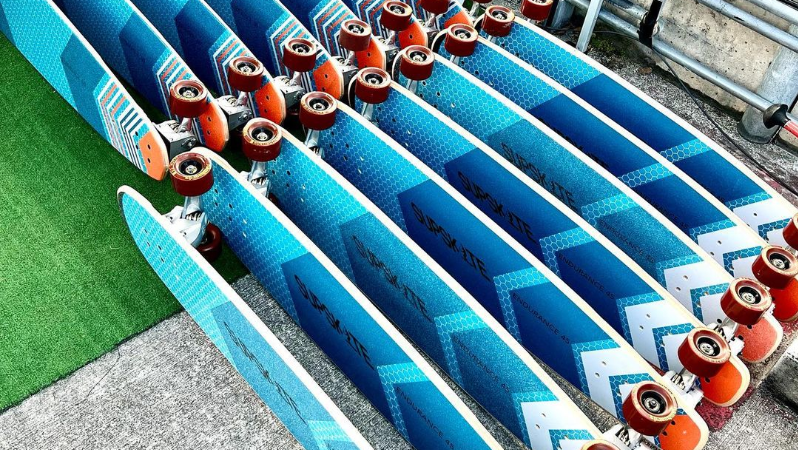
Why should we care about the SUPSKATE ENDURANCE boards?
Share
At SUPSKATE, our goal is to design and manufacture a specialty boards that are mass producible with the necessities to facilitate pumping while also providing an approachable board that's comfortable to ride for anyone.
That's why we say that the "ENDURANCE boards aren't for everyone, but they are for ANYONE who wants to learn how to participate in this sport." The the majority of the SSUP team riders at the '22 Miami Ultraskate used the ENDURANCE 45in and 60in boards, while the very top individual athletes used their own custom made boards.
The very top distance athletes (outliers) use VERY specialized skateboards with 50~55 degree pivot axis on the front and as close to zero degree on the back as possible. Further the back axel is as narrow as possible. The very light weight decks range from 30~60 inches long, are fairly narrow and can be highly flexible with some concave shape. Most people can't ride these specialized boards. They're not all that easy to master, in fact I still haven't put enough time in to master them. The rider needs precise footwork, exceptional balance and strong technique. In order to use a pole with a board like this, precise footwork is even more important because it can be challenging to get your hips pointed forward, which is essential for most people to switch sides while paddling. The best athletes can "skogg" where they alternate the front foot. (Skogging feels really awkward for most people, who have a dominant front foot.). These boards are generally expensive and assembled by each long distance athlete with components of their own personal preference. There are many different configurations, but we've noticed some common threads in most of these high performance boards.
- The decks are light, flexible, narrow and sized to the riders stance.
- There is a 40 to 55 degree difference between the front and back pivot axis.
- The front hangers are wider than the back.
- Big wheels are better than small wheels
We also observed the following:
- Most people don't feel comfortable with a 50 degree pivot axis difference, but a 40 degree difference seems to be manageable.
- The concave decks tends to hurt the riders feet after standing on a board for a long time.
- The wider the deck, the easier it is to keep both feet pointed forwards to keep hips pointing forward, which is necessary for most people to switch arms.
- Most people will never figure out how to skogg, so it's not good to expect them to develop that skill.
- Most people like to have fun carving AND making distances. The boards should also have the ability to convert from long distance into carving rides.
This formed the basic assumptions when we designed the Endurance boards.
Endurance 45in All Star - Light weight, nimble and highly pumpable and ~3.5 ft turning radius (7ft diameter).


Endurance 60in All Star - Most comfortable and easiest to pump and ~5 ft turning radius (10ft diameter).


ENDURANCE boards are specially made for long distance skate poling. They're wide and flat decks with 40 degree pivot axis on the front truck and a ZR0 degree pivot axis on the back truck. Further the front axel is 200mm wide and the rear is 160mm wide.
"The Sentient 60 planted my feet, spoke a few fine words, and literally taught me how to pump. The Flying 45 is lighter and predictably more nimble. Awesome boards." - B. Ennis; First time 2022 Miami Ultraskate athlete.
"They nailed the pumpability with the new HST 2.0 trucks. The 45 is my size, but if you want to get some attention, the 60 will certainly accomplish that." - A. Andras; 2022 Miami Ultraskate World Record holder; 273 miles in 24 hours.

